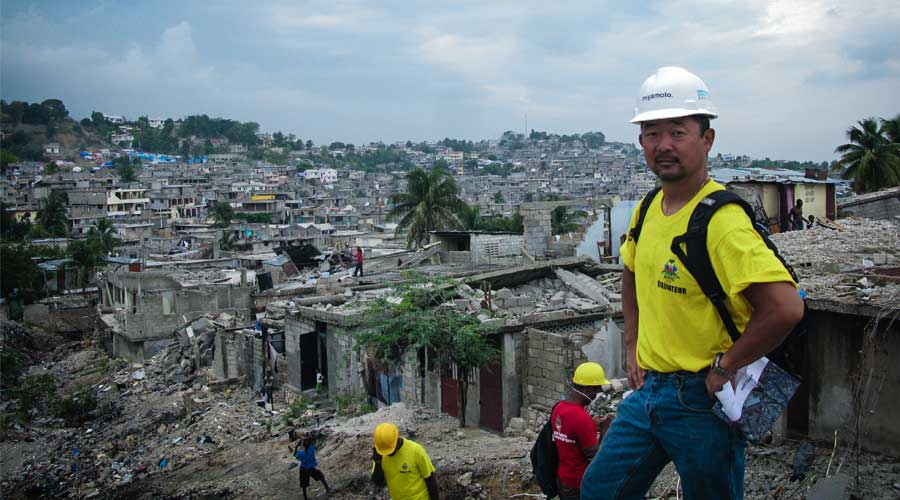How building disaster-resilient structures can lift a nation
By Dr. Kit Miyamoto
In 30 years of responding to earthquakes, I have never seen destruction like what I witnessed in Haiti a decade ago. Traveling through the wreckage of Port-au-Prince just days after the earthquake of Jan. 12, 2010, I saw a hellish landscape: people digging through concrete for missing family, twisted metal, cars squashed under buildings, a distant hillside slum turned into total devastation.
As a structural engineer, I have assessed the damage of over 100 earthquakes worldwide, and I lament the fact that history keeps repeating itself. Right now, while I survey the damages in Puerto Rico, I’m reminded that the lessons learned in tragedies like Haiti’s hardly reach across neighboring islands and sometimes are even forgotten within the same country.
How are we as engineers failing to inform people?
In Cap Haitien, a city on the north coast of Haiti unaffected in 2010, for instance, they continue to build in the same risky way as before – with low-quality, unreinforced concrete. Though a national building code was finally developed, there are still major issues with enforcing. Multiple recent earthquakes in nearby Puerto Rico should remind Haitians yet again that they are still at serious risk of another catastrophe.
Haiti’s earthquake, after all, was more than just a natural disaster. It was an engineering disaster. More than 200,000 people lost their lives and nearly 300,000 buildings were destroyed, including not only homes and businesses, but also emergency command centers, hospitals, an airport, government buildings and the supposedly indestructible national palace. From an engineer’s perspective, at least half of that destruction and death could have been avoided with the use of simple, earthquake-resistant construction methods.
‘How are we as engineers failing to inform people?’ I asked in my field journal in 2010, and I ask it again after every disaster.

I know the construction workers, engineers and masons we have trained in post-earthquake areas around the world won’t make these same mistakes again – the solutions are usually cheap and easy. Training is also part of my mission in Puerto Rico, which hasn’t experienced an earthquake like this in 100 years, and where most engineers simply aren’t taught about seismic construction or damage assessments.
When I go back to Port-au-Prince, even in the informal neighborhoods untouched by government or building regulations, the majority of homes I see now have code compliant elements. With every house we repaired in 2010, we taught construction workers easy, inexpensive ways to build better – like how to reinforce walls or bend steel to strengthen columns. We trained over 7,000 masons alone.
While humanitarian agencies rushed to set up temporary shelters in Haiti, our team focused on a different challenge: how to get families out of the camps and back into safe homes as fast as possible. After training 600 Haitian engineers, we triaged over 400,000 buildings and spray painted them red (do not enter), yellow (needs repair) and green (safe to return). We set out to repair 500 yellow-tagged houses, but 500 turned into more than 10,000.
Homeowner-driven efforts were the biggest success of Haiti’s problematic recovery. When given small subsidies for repairs, homeowners spent it on local materials and labor. According to the World Bank, every housing unit built creates an average of five jobs. The money spent on foreign-built “temporary” shelters ($500 million, by the way) could have been better spent investing in simple repairs that return families to their homes, stimulate the economy, employ people and develop life-saving construction skills.
But when the news dies down, how can we ensure these terrible lessons are remembered by homeowners, government officials, banks and relief agencies before tragedy strikes again?

Every dollar invested in safe, disaster-resilient construction saves $11 in damage and disruption. And if that statistic is too abstract to convince the person saving up pennies to build their home, we need to find better ways to send the message. This knowledge and just a small investment can mean the difference between life and death.
Schools, too, are one of the deadliest structures, but it costs just 1 to 3% more than the original construction budget to build one the right way, the first time around.
In poor neighborhoods in Haiti and throughout the world, building codes are not enforced and government support is nonexistent, so many families construct their own homes. The prevalence of informal housing in Haiti is extreme, but it’s not unique. UN Habitat estimates that in the next 15 years, three billion people will live in substandard homes.
Just ask the 1.5 million individuals displaced by the earthquake in Haiti – after a disaster, structures are about more than just walls and a roof. When built proudly and properly, they are businesses, they are assets, they are collateral for loans. They are safe schools to send your children to and peace of mind while you look for work. They are offices to run the country and coordinate recovery. They are construction sites and training centers that stimulate the economy and employ thousands. They are homes that reunite families and provide solace amid chaos and trauma.
Our built environment is the foundation of our cities and those who build and rebuild it are our best chance to make sure we never repeat this mistake again.

